PROVENCE
Welcome in Provence! A unique place with an infinite number of treasures… Breathtaking landscapes, villages steeped with history, an incredible gastronomy, delicious wines, to mention but a few… The provençal cultural wealth is yours to discover! So, to give you a foretaste of what lies ahead, we prepared just for you a list of what is not to be missed during your stay in our wonderful region. You will learn and experience even more of our beloved culture during your small-group tour with one of our tour guide!
It is now time to let yourself guided and be amazed in Provence with our A la Francaise Provence team!
Abbey of Sénanque
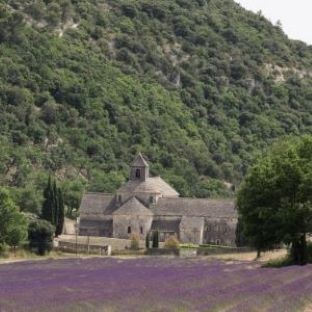
The Senanque Abbey has become one of the symbols of Provence because it’s a topic of postcard! This Cistercian abbey from the 12th century still is occupied by monks today, who live thanks to tourism and lavender agriculture.
The place became famous thanks to the beautiful lavender field situated around the abbey. It’s since 1960 than the monks started to cultivate what we called «the blue gold» of Provence and it makes of the area a very peaceful place.
You will enjoy the serenity and the beauty of the landscape walking around the abbey and the fields. Inside you can also appreciate a large bookstore with cultural and religious works but also the different products elaborated by the monks such as lavandin essential oil, perfume and lavender honey…
If the abbey is one of the highlights of your trip you must know that on a private tour, you can visit the inside of the building to discover the architecture and the life of the monks. Inside you can discover the former dormitory, the ch ...
Aix-en-Provence
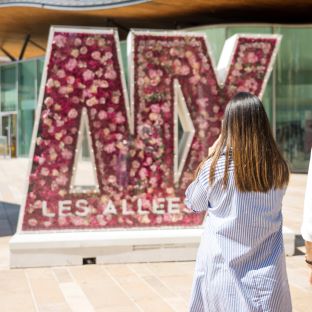
First roman foundation in Gaul, first called Aquae Sextiae, then capital of the county of Provence, Aix-en-Provence is a city of History, a city of art, and a city of water. A true cultural crossing which evolved with its time while keeping his Provençal identity, making it a privileged travel destination.
In the middle of a typical Mediterranean countryside dominated by Cézanne’s mountain, the Sainte-Victoire, Aix-en-Provence is above all an art of living. Come have a drink on one of the numerous terraces, or go to take a walk around medieval streets punctuated by majestic fountains and fancy private mansions from 17th and 18th centuries.
Aix-en-Provence is also a city of taste! Have a try at the famous Calissons, local specialty since the middles ages. Taste some olive oil, "tapenades", Provence wines, "nougat"... before going out at night and have a delicious Provencal meal. Thanks to its location, the city is the perfect departure point for trips in Provence: Marseille, Avignon, ...
Arles, the “little Rome” of Provence
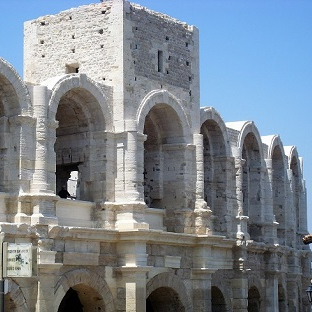
Arles, the "little Rome" of Provence: Arles may not be the biggest Provençal city, but definitely one of the richest. Known mainly for its roman and Romanesque heritage, it’s been inscribed on the UNESCO world heritage in 1981. Clearly, you cannot miss the roman amphitheater, like a miniature Coliseum in the heart of the city. Your eyes will be attracted by the Saint Trophime church, especially its porch entrance: a XII century sculpture masterpiece. Just enough to make you want to visit the cloister where you will find a same subtle carving.
More than a period of time, it is also thanks to a man that Arles is so internationally known nowadays: Vincent Van Gogh. Wandering through the streets, gazing at wheat, olive or sunflower fields you will better understand the light which inspired him so much. Even if he came here in 1888, some of its paintings can still be read on a café walls (Le café de nuit, 1888) or in the ancient hospital courtyard (La cour de l’hôpital d’Arles, 1889).
But ...
Avignon
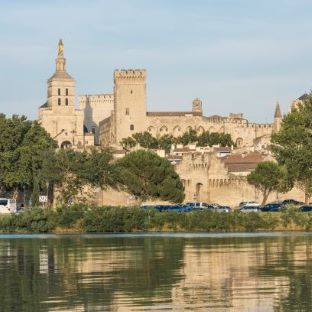
Settled on the left bank of the Rhone river, Avignon is one of the few French cities that kept its ramparts, protecting its historic center embellished by many architectural beauties such as the impressive Popes' Palace, one of the largest and most important Middle Age's Gothic buildings. The majestic Rocher des Doms, a rocky spur surrounded by its green garden that offers a panoramic overview above the Rhone river. And also the famous Pont d'Avignon (Saint-Bénézet Bridge), main witness of the history of the city, now classified on the UNESCO World Heritage Site.
The papal city is the perfect reflection of the way of life in Provence: walk into the narrow cobblestones streets, cafés exposed to the sun, lots of local restaurants and theaters, colorful landscape and regional wines…
The Popes' city is also the Côtes du Rhone capital: a register designation of origin (AOC) wine, produced on the right and left riverbanks between Vienna and Avignon.
Every summer, the city is punctuated by ...
Les Baux de Provence
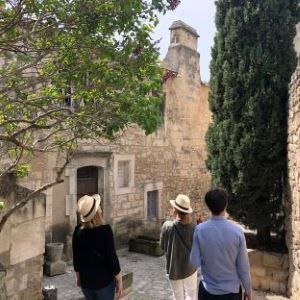
You cannot miss the visit of the village of Les Baux de Provence during your trip in the region. The village has been classified as one of the most beautiful village of France thanks to its astonishing situation and its medieval architecture. Situated on the top of a crag of 245 meters high, the village offers a 360° view over the Alpilles mountains, the national park of Camargue and the territory of Arles.
During your tour in the village you will enjoy the narrow-paved streets, the medieval houses made with limestone with carved decorations, the private mansions from 16th and 17th centuries and of course its castle. This castle dates from 11th to 13th century and is now classified as an historical monument as one part of the building is troglodyte. Even if the castle is partly destroyed, the site organizes lots of events and reconstitution from medieval jobs during weekends and school holidays.
The village is also full of small handcraft shops, cafés and restaurants. Don’t miss the ...
Baux de Provence
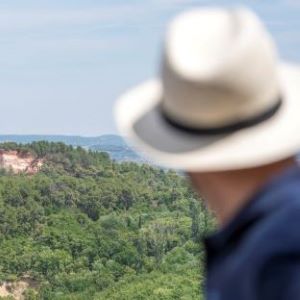
Les Baux de Provence: The visit of the village of « Les Baux de Provence » is a worth during your trip in the region. The village has been classified as one of the most beautiful village of France thanks to its astonishing situation and its medieval architecture. Situated on the top of a crag high of 245 meters, the village offers a 360° view other the Alpilles mountains the national park of Camargue and the territory of Arles. During your tour in the village you will enjoy the narrow-paved streets, the medieval houses made with limestone with carved decorations, the private mansions from 16th 17th century and of course its castle. This castle dates from 11th to 13th century and is now classified as an historical monument as one part of the building is troglodyte. Even if the castle is partly destroyed, the site organizes lot of events and reconstitution from medieval jobs during weekends and school holidays. The village is also full of small handcraft shops, cafés and restaurants. Don ...
Camargue
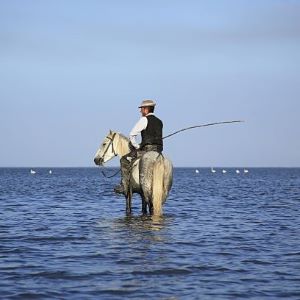
On the shore of the Mediterranean Sea, in a typical western landscape, the great outdoors criss-crossed by bulls and wild horses constitute a fully-fledged universe. Land of tradition, camarguaise race and the gypsies pilgrimage rhythm life throughout the year. The Camargue, located in the Delta of the Rhone, biggest delta in Europe covering 150 000 acres, has appeared in his actual form 7000 years ago thanks to sand and loam that was brought by the waters of the river. The mixed actions of the freshwater of the river and the salty one of the sea created this mosaic of lagoons separated by canals. A big dyke was built in 1859 protect the delta from the floods, from where we can watch today a great number of species of birds, such as aigrettes, herons and the famous pink flamingo that we can see all year long in the rich lagoons.
https://www.alafrancaise.fr/en/provence/small-group-tours-minibus
...
Cassis
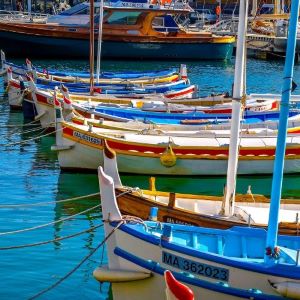
Cassis is a pretty fishing port located east of Marseille. No connection with the liquor of cassis (blackcurrant) which is made in other regions in France, but there are 12 wineries in Cassis producing wonderful white wines thanks to its microclimate. Dry but fruity, usually mineral, sometimes iodic, the wine from Cassis pairs very well with the fish and Provençal food you can eat in one of the many restaurants on the port. They are surrounded by the bright colors of the façades and the ‘pointus’, local boats moored on the quay. It’s from one of the docks that you can start a boat ride along the calanques. These long and narrow coves of blue translucent water are so beautiful that a National Park is protecting them.
And don’t miss the opportunity to enjoy a dizzying view over the town and the coast from the Cape Canaille. This place is known as the highest sea cliff in France! As the name suggests the three main calanques are situated to the west of this charming seaside town. Here th ...
Châteauneuf-du-Pape
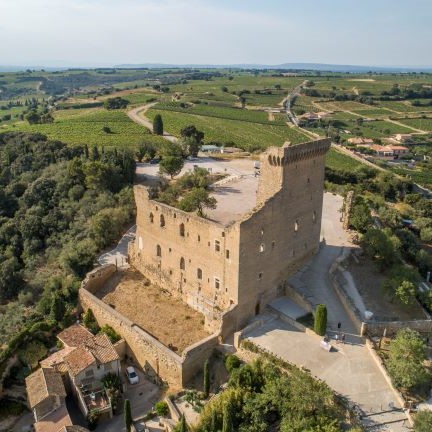
Up on the hill, the castle of Châteauneuf-du-Pape overlooks most of the vineyards that have made this town famous. Wine was produced here, apparently, since the roman time but thanks to Jean XXII (second pope of Avignon, 1316-1334), it went to the pope’s table. It became better and more and more plots appeared. It is nowadays one of the most well-known "cru" of the southern Rhône valley, located between the Rhône river and next to the Mont Ventoux, highest peak in Provence (1911m).
Geographically, this appellation receives a strong Mistral, noteworthy wind which comes from the North bringing sun and sanitary state to the lands. Combined to this climate, there is a typical soil: the pebbles which keep heat from day and give it back at night. Next to them, you can also find limestone, sand and sandstone soil but they are the signature of this cru.
Each year, winegrowers and winemakers express the quality of this terroir in the 13 varieties allowed, in which the Grenache is the main one ...
Fontaine de Vaucluse
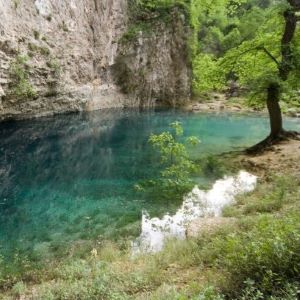
The name Fontaine-de-Vaucluse, comes from the spring located between the village and a cliff of the Vaucluse's mountains. This spring is the fifth most important in the world: it is the mother of the Sorgue river who is crossing the town in a beautiful web of water. The sky of Provence is blue like the sea, it doesn't share its rain often, which explains why the water became an important symbol of life in this country. Many civilizations live up next to this spring.
The Greek civilization was already there before the Romans, and build an aqueduct. The paper mills from the fifteenth century are still giving their charms to the town's shores, as much as the castle of the 12th century.
In this village the water is everywhere, it carries a legendary folklore of dragons and fairies, its color is clear like the crystal, and we can hear it singing in every streets and feel it in the green nature of the village. Across the ages, the human's constructions and the wild nature mixed with each o ...
Gordes
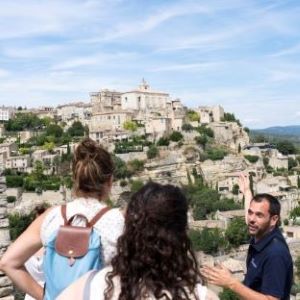
Gordes is a living fossil that the time can't break. Humanity started to live here since more than five thousand years, and then crossing the centuries of a ruthless history; wars, starvation, epidemics and earthquake to finally get bombed during the Second World War.
Today this village went out from these storms with unique authenticity and beauty, listed as one of the most beautiful village of France and it's also one of the most visited in Provence.
From the village, in the South, there is an ocean of vineyard with many cypress. It looks like Tuscany but with a difference; because according to the seasons, the lavender fields, the sunflower fields and the red poppies fields are coming to give their colors to the panorama. In the North, there is the Vaucluse mountains and their wild nature, the forests hide many secrets, especially the old abbey of Senanque surrounded by the lavender fields, built during the 12th century by the Cistercian monks. It is still occupied today! In Prove ...
L'Isle-sur-la-Sorgue
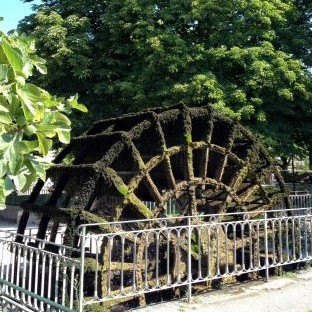
L'Isle-sur-la-Sorgue is a small town who developed itself next to the Sorgue river over centuries. The name of this town makes more sens when you discover the place (L'Isle-sur-la-Sorgue means the island on the Sorgue river) because the town is literally surrounded by water, that why its nickname is « The Venice of Provence ».
The atmosphere is full of romance; the watermills which started to turn during the thirteenth century to supply the first sheet factories are still here, and some of them are still running on the river. People are very gourmand in L'Isle-sur-la-Sorgue, we can find many traditional confectioneries from Provence, the traditional markets are full of fruits and vegetables which come from the lands around, in the restaurants they cook freshly caught fish.
Nowadays, L'Isle-sur-la-Sorgue is the European capital of the antique dealers, in the picturesque streets and the river's bank we can see the traders and their old items, many artists and artisans decided to work t ...
Lourmarin
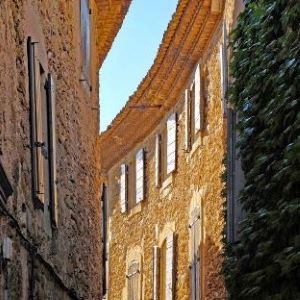
The Luberon is a country full of beauty and history. The village of Lourmarin is one of its main entrances where travelers stopped and stayed during the 12th century. It is good to keep this tradition today, even though we get the risk to never come back, because this place, listed as one of the most beautiful village of France, seems to come from a picture.
The story of this place starts during the Antiquity and has cross the ages to give us today one of this typical image of Provence that Peter Mayle loved so much; across the streets it looks like time stopped, during the summer people are lazy on the terrace of the cafes, enjoying the eternal blue sky.
The castle adds a unique charm thanks to the Renaissance estheticism. Today, according to the local superstitionn, this castle has magic powers... but to believe or not to believe, everybody agrees with this fact: this castle has one of the best panorama from where you will get to see the village with its fields of olive trees, its ...
Farmer's Market
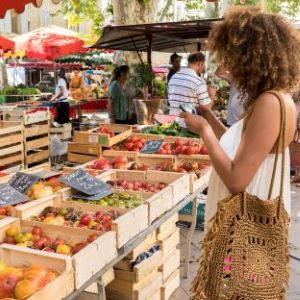
Coming in Provence without going into a market is impossible, you will find some everywhere! Each city, village, district has its own market with its own typicity, but the best are the farmers’ ones!
With more than 300 sunny days per year and large rivers and springs, the agriculture in Provence is highly developed. You will see it while visiting markets at any season: fresh fruits and vegetables are waiting for you. Wander around the colorful stalls, smell the different products and enjoy one of the perfect example of the Mediterranean lifestyle.
https://www.alafrancaise.fr/en/provence/small-group-tours-minibus
...
Marseille
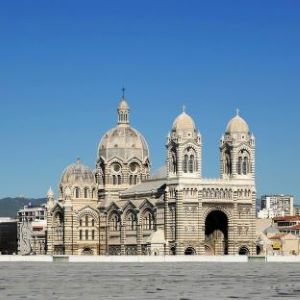
Thanks to its natural harbor, Marseille, the ancient city of Massalia was an important shipping port for the Phoceans. Remnants of its ancient maritime history can still be seen at the Jardin des Vestiges. The oldest part of the city situated on the northern side of the port was the site of a walled settlement which included temples, theatres, amphitheaters and market places. Today it is the disctrict of Le Panier with its narrow streets, shaded squares, terraced restaurants and artisanal shops. A melting pot of cultures, this vibrant city is France's biggest port on the Mediteranean Sea and the country’s second largest city after Paris.Thanks to important investments in transportation, leisure and cultural infrastructures, the city renewed itself becoming in 2013 the European capital of culture. The city also opened the now famous MUCEM and the Mediterranean Villa, reinforcing its position as a top tourist destination.
https://www.alafrancaise.fr/en/provence/small-group-tours-minibus ...
King René
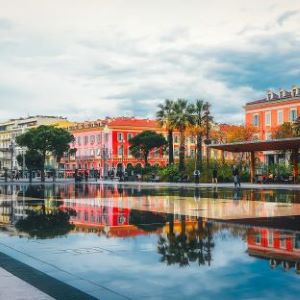
Named « the good king » by the Provencal people, René the 1st of Anjou is, for sure, one of the most famous character of the Middle Age in Provence. He was a great artisan of strong irrigation and developed the agriculture in the region. Lover of art and poesy, his court in Aix en Provence still influences this city where you can see his statue nowadays on the Mirabeau avenue. In the region, everyone knows the famous Calisson of Aix-en-Provence, a sweet confectionery which, according to the legend, was created for the wedding of the great king. You can find and taste some nowadays in Aix en Provence and other cities of the region. ...
L'Occitane en Provence

The brand « L’Occitane en Provence » is above all a story of passion. Olivier Baussan was 23 when he started distilling essential oil in Manosque, near lavender fields. With his van, he travelled the local markets of Provence and thanks to a friend who worked in business, he opened his first shops. Few decades later, the company works with more than 130 farmers in the South of France to provide the world in cosmetics, soaps, fragrances, known and used everywhere.
L’Occitane is also engaged in many causes through the creation of different programs such as recycling, supporting local producers, developing women independence throughout world…
https://www.alafrancaise.fr/en/provence/small-group-tours-minibus
...
Ocher
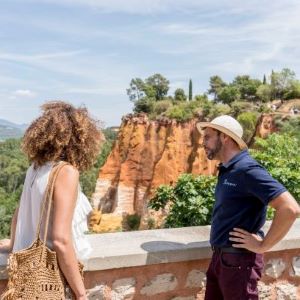
Ocher, this mineral pigment, has been exploited since Antiquity in the Luberon. Already extracted by the Romans, it was at that time intended for local uses. Later, it was in Roussillon that the exploitation of ocher intensified, and that it took on an industrial scale (18th century), an industry which also flourished in the 19th century. Ocher is a geological wonder, the range of colors of the ocher sands of the Luberon is impressive and changes according to the oxidation, from red to yellow. Ocre has been coloring the Luberon for years, since Provence emerged from the seas a hundred million years ago.
In Roussillon you can walk the Ocher footpath, a trail open to the public. The walk in the middle of the colorful ocher universe is just exceptional and totally exotic. Do not forget your camera!
https://www.alafrancaise.fr/en/provence/small-group-tours-minibus
...
The Popes' Palace
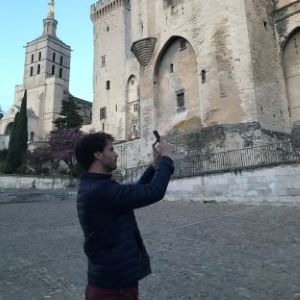
Symbol of the city of Avignon, the Popes' Palace emerges above the houses like a stone ship in the middle of the Rhone River. Built by two of the nine popes who lived in the city during the Middle Ages, the Old Palace and the New Palace became the administrative, religious and economic heart of Christianity for 100 years. This fortress offers austere facades which keep the most beautiful medieval jewels in its midst. The wooden ceilings, Italian frescos of the greatest artists of the time and medieval tiles will bring you to the splendor of the papacy. From papal residence to military barracks, you will discover the tumults that have marked the history of this building by visiting the 25 rooms open to the public. Every summer, the whole palace becomes once again the setting of artistic creation by hosting performances of the Festival d'Avignon giving it back its place as cultural capital.
https://www.alafrancaise.fr/en/provence/small-group-tours-minibus
...
Avignon bridge
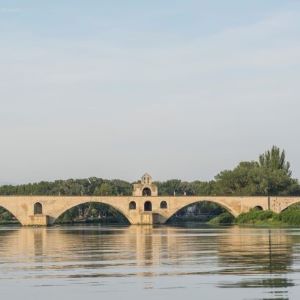
Every French people know the bridge of Avignon, even if a majority never saw it for real. The song made it famous but a majority does not know its real name, the Saint Bénezet bridge. Commissioned by an angel to a young shepherd named Bénezet, this bridge had since the Middle Ages, a primordial role for the city of Avignon. First bridge over the Rhone river from the sea, it was the border between Villeneuve and Avignon but especially between France and the Holy Roman Empire. The bridge will be rebuilt as often as destroyed by the powerful water of the river. A last flood in the 17th century left it on these 4 arches protected by the chapels of Saint-Nicolas and Saint-Bénezet. Today you will always hear some visitors mumbling while holding hands « Sur le pont d’Avignon on y danse, on y danse. Sur le pont d’Avignon on y danse tous en rond ». ...
The Pont du Gard
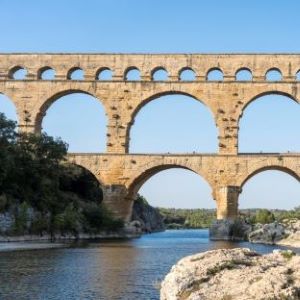
The Pont du Gard is one of the main monuments in Provence, inscribed on the UNESCO world heritage in 1985. It’s a remain of the very impressive aqueduct built during the 1st century AD, that linked the Eure’s spring (next to Uzes) to Nemaussus (current Nîmes). Based on the De Architectura from Vitruve, this work is about 50 km long with one of the smallest drop known: 24cm a kilometer. Even if the Pont du Gard is just a piece of 200 meters long, it is the most majestic part of it. It’s 50 meters tall, and 3 arches levels make it cross the Gardon river. Above the last level takes place the channel where the water used to pass , there is still a part covered with slabs. This technical masterpiece, old from 2 000 years, is set in a characteristically natural site: limestone rocks, green oaks, olive trees. One of the most visited site in France, it has been first done as a practical work first and not as a monument. ...
The Julien Bridge
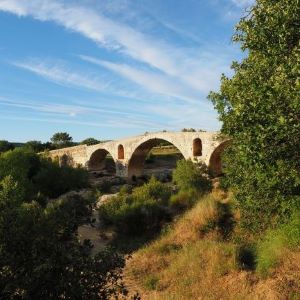
Named after Julius Caesar, this bridge built on the Via Domitia (Roman way connecting Turin to Narbonne) in the 1st Century BC is an impressive witness of Roman engineering, used by traffic until 2005. It never failed to his task. Less famous than other roman remains of the region, it is still worth a photo stop. ...
King René
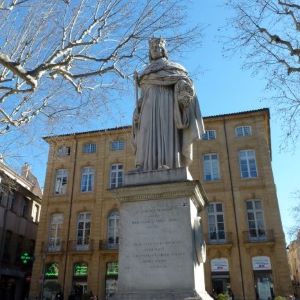
Named « the good king » by the Provencal people, René the 1st of Anjou is, for sure, one of the most famous character of the Middle Age in Provence.
He was a great artisan of strong irrigation and developed the agriculture in the region. Lover of art and poetry, his court in Aix en Provence still influences this city where you can see his statue nowadays on the Mirabeau avenue. In the region, everyone knows the famous Calisson of Aix-en-Provence, a sweet confectionery which, according to the legend, was created for the wedding of the great king. You can find and taste some nowadays in Aix en Provence and other cities of the region.
https://www.alafrancaise.fr/en/provence/small-group-tours-minibus
...
Roussillon

Welcome in Roussillon, one of the most beautiful villages in France and who likes to boast about its originality. In Provence this village is a rebel and does not want to be like the others. Gradually as we are approaching the village, the lands and the hills become full of colors. Every houses are red, orange or yellow. A local legend explains that the ground of this country became red like blood after a terrible and tragic love story, and an another one tells us that the Titans burned the ground to punish the inhabitants for their disobedience... But whatever the story, today the small village of Roussillon is shining with provocation on all of the Luberon. It's the ochre who give this r0ed color to the ground since one hundred ten million year. The Greek and the Roman civilization already used the ochre to paint their pottery, but it's during the eighteenth century that Roussillon became a real Eldorado; the painters and the dyers are attracted by the color. Today the mines of ochre ...
The Saint Victoire mountain
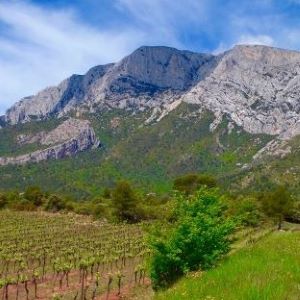
The Saint Victoire mountain can be seen from many miles and wherever from we arrive. It imposes to the visitor its compact mass, appearing from the countryside of Aix-en-Provence like a lost ship. The northern slope is covered by wood and scrubland until the summit while the Southern one raises a mineral barrier on the Arc river valley and extends vineyards and olives groves. The wines produced are among the best rosés of Provence thanks to PDO “Côtes de Provence Sainte Victoire”. There also is an excellent quality olive oil. This massif inspires painters since centuries, but it is Paul Cézanne, native from Aix-en-Provence, who gave the mountain access to the greatest museums in the world. The “Sainte Victoire” mountain is classified as “Grand site de France” (Great French Site) since year 2000, and whether it is for sports, cultural or gastronomic reasons, you will be pleased by that mountain. ...
Sault
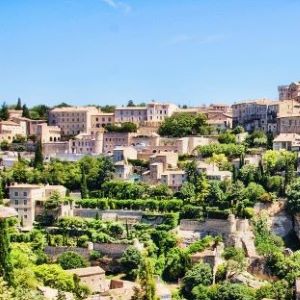
Located on the southern side of Mont Ventoux, the highest mountain of Provence with its 1900 meters, Sault is a scenic village whose history dates back to the medieval times. Built on a rock spur, the village dominates the plateau that takes its name, where, in summer, the gold of wheat melts with the blue of lavender. At one hour and fifteen minutes driving from Avignon and one and forty-five minutes from Aix-en-Provence, it is the ideal starting point for exploring the Mont Ventoux. In the middle of one of the most beautiful countryside of Provence, the village is known for fine lavender. Actually, the average altitude of the limestone plateau that surrounds it, between 800 and 1000 meters on the level of the sea, favors the cultivation of fine lavender, which does not grow below such altitudes. Thus, between July and August, while driving on its roads, one goes to discover the fine lavender fields, with incredible colors and smells, between the hilly areas and the large spaces of th ...
The Truffle
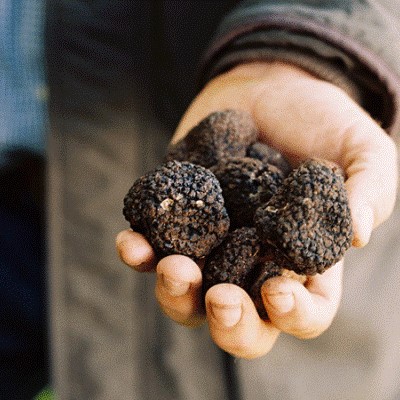
The « black diamond » of Provence is a superstar here, during summer or winter, white or black, sliced or macerated into olive oil, you’ll find truffle at any time and any place!
Provence, especially the Luberon, is the main French region of production of that mysterious mushroom. Named « La Rabasse » in the provencal dialect, this product is an emblem of the local gastronomy.
...
Valensole
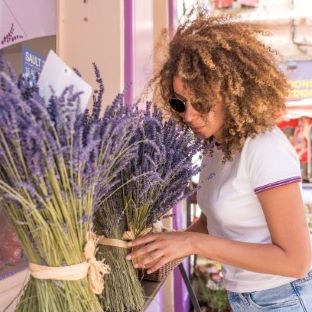
At one hour driving from Aix-en-Provence is one of the most famous areas for lavender in Provence. As the meaning of the name says (from latin vallis solis: sun valley) the Valensole plateau is an area where sun shines for 300 days a year over a surface of 800 square kilometers, offering to the lavender the best conditions to grow. Driving along its roads between mid-June and mid-July is a unique experience to get soaked with the magic of the lavender blooming fields. The medieval village of Valensole is set in the middle of the plateau, surrounded by mountains, at the edge of the Verdon's natural regional park. Since the past its farming vocation didn't change and in the last 90 years it has been focused on the lavender cultivation. Just aside the large lavender fields we do find family-run distilleries, into which « the blue gold of Provence » is scented to get the essential oil. Inside the village many little shops and boutiques offers a whole range of products made with lavender, s ...
Vincent Van Gogh
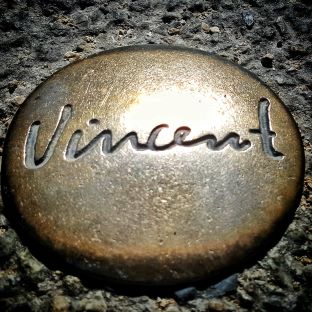
Vincent Van Gogh left Auvers sur Oise in 1888 and settled in the city of Arles. He fell in love with the light and the vibrant colors of south of France. In Arles he received the visit of his friend Paul Gauguin; they both painted a lot, like The Sunflowers and The Bedroom. But their cohabitation ended with the well-known incident of the cut of his ear after a fight…Vincent was cured in the hospital of Arles for a month, and after his neighbors refused him to get back to his yellow house Place Lamartine. So he decided to settle in Saint Remy, in the asylum of Saint Paul de Mausole. In this old monastery, that can be visited today, he found inner peace for about a year and painted the worldwide famous Irises. In Provence you can follow in the footsteps of Van Gogh in the city of Arles and Saint Remy, were reproductions of his masterpieces were placed at the exact location where they were painted!
https://www.alafrancaise.fr/en/provence/small-group-tours-minibus
...


